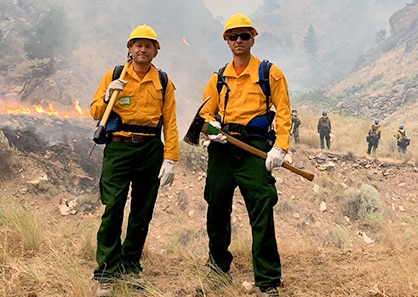Wildland Firefighter Exposure and Health Effects Study

NIOSH researchers observe firefighting activities as part of the 2018 Wildland Firefighter Exposure and Health Effects (WFFEHE) study.
NIOSH, in partnership with the United States Forest Service (USFS) and the United States Department of the Interior (DOI), started the Wildland Firefighter Exposure and Health Effects (WFFEHE) study in the spring of 2018. The study was meant to follow a group of federally-employed wildland firefighters (WFFs) over three fire seasons. However, because of the COVID-19 pandemic, WFFs were only followed for two seasons. The purpose of this study was to understand better the potential chemical and physical hazards associated with wildland firefighting and how these exposures affect WFFs’ health, especially after multiple fire seasons. We were interested in the effects on the WFFs’:
- lungs,
- heart,
- kidneys, and
- hearing.
Why we conducted this study?
We conducted this study because we do not have a clear understanding of the potential health effects from exposures to WFFs throughout multiple wildfire seasons.
Who participated in the study?
Study participants volunteered from wildland fire crews from the USFS and the DOI, National Park Service. During the 2018 and 2019 fire season, over 150 WFFs from six fire crews volunteered to participate in the study.
What did the study participants do?
Pre-season and post-season
During the 2018 and 2019 fire seasons, researchers interacted with WFF study participants from all six crews at pre-season and post-season. Pre-season testing occurred as close to each crew’s official start date as possible (April/May each year), and post-season testing occurred as close to each crew’s official end date as possible (September/October each year). At each pre-season and post-season interaction, we asked each participant to volunteer to:
- fill out questionnaires about their work and health history and health behaviors,
- have their height and weight measured,
- have their blood drawn to measure cardiovascular, kidney, and inflammatory markers,
- participate in lung function tests,
- participate in hearing tests, and
- participate in non-invasive cardiovascular measures.
Mid-season
During the 2019 fire season, researchers followed one firefighting crew during a mid-season live fire to better understand WFFs’ health and exposures during this critical period. In addition to all the tests above, we also asked study participants from this crew to:
- give urine at pre-, mid-, and post-season to measure their biological uptake of combustion products,
- wear air sampling devices during their mid-season work shift to measure their inhalation exposure to combustion products, and
- allow NIOSH researchers to follow and observe them during their mid-season work shift.
When will the study results be released?
The purpose of this study is to evaluate a variety of health measures and exposures among WFFs over multiple fire seasons. NIOSH and our partners are currently analyzing data and publishing findings and recommendations. As information becomes available, we will update this webpage. Learn more in this video about the project published by Wildland Fire Lessons Learned Center.
The Wildland Firefighter Exposure and Health Effect (WFFEHE) Study: Rationale, Design, and Methods of a Repeated-Measure Study
The wildland firefighter exposure and health effect (WFFEHE) study was a 2-year repeated-measures study to investigate occupational exposures and acute and subacute health effects among wildland firefighters.
